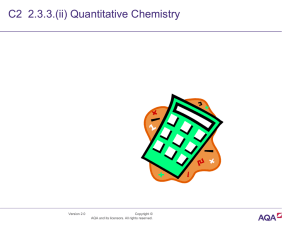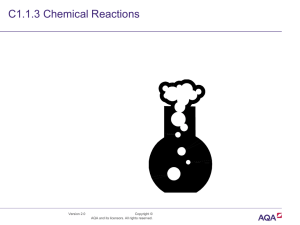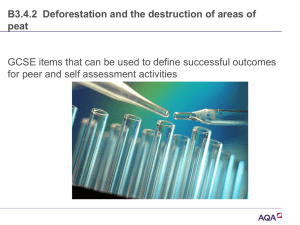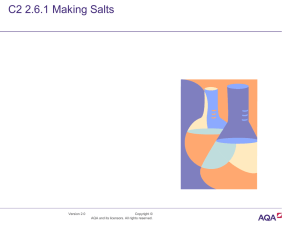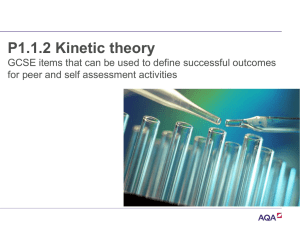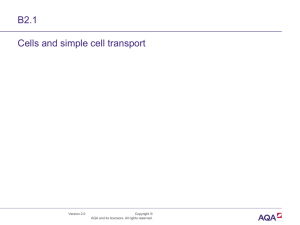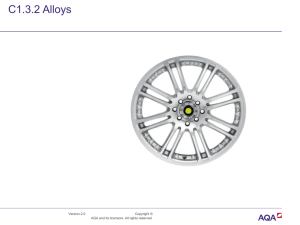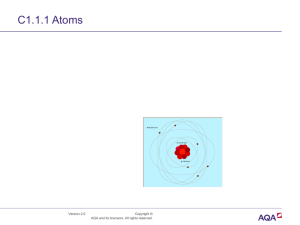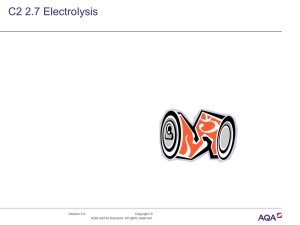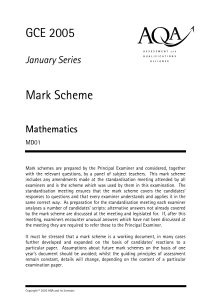Ready for Maths in Science?
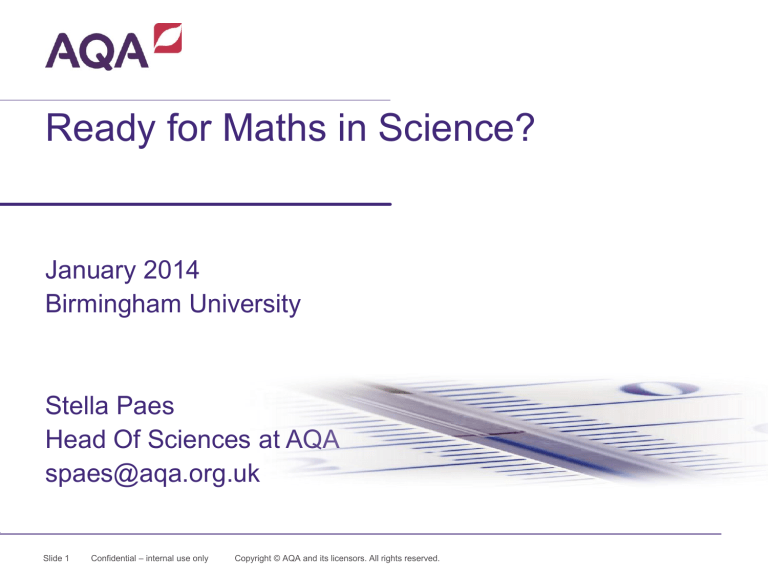
Ready for Maths in Science?
January 2014
Birmingham University
Stella Paes
Head Of Sciences at AQA spaes@aqa.org.uk
Slide 1 Confidential
– internal use only Copyright © AQA and its licensors. All rights reserved.
Scientific communication has Mathematical language and models at its heart
Engineers and scientists spend over half their time reading and writing science
The knowledge and skills required to read and write science are discipline specific and can only be acquired in the science classroom
Interpretation of data is a theory laden process
Mathematics is not a tool for analysing data but a tool for scientific thinking
Jonathan Osborne SSR Dec2011
Version 2.0
Copyright © AQA and its licensors. All rights reserved.
Context: Key concerns about Mathematics in A level sciences
• A SCORE concern about the range in the amount of mathematics between A-level sciences, eg Biology (16-35%)
• a concern that most maths assessed was ‘familiar maths’ such as standard form, estimates, rates of change, …
• big concern from universities was lack of practice and therefore fluency students unable to go beyond the expected… making them unprepared for university
• concern about the low level of multi-step calculations - a view held by scientific community that there should be guidance for awarding organisations on how much mathematical content should be included
Draft version 08 July 2013
Confidential
– internal use only Copyright ©
AQA and its licensors. All
“If they were music students they would need to practise their scales. They just need more practice, until algebraic manipulations, powers, logs etc all come naturally and quickly to them.
Then they can start to play the sonatas, concertos and symphonies that are physics.”
Mi n d t h e G a p : Ma t h e m a t i c s a n d t h e T r a n s i t i o n f r o m A - l e v e l s t o P h y s i c s a n d E n g i n e e r i n g D e g r e e s J u l y 2 011
A summary of the proposed plans for A-level Biology,
Chemistry and Physics:
• changes to improve the clarity, sequencing and coverage of AS and A level content
• mathematical requirements strengthened and more consistent so that students apply mathematics at the level needed to fully support scientific knowledge, understanding and problem solving
• the mathematical requirements are:
– a clear requirement that mathematical skill is taught and understood beyond the level of maths required for a GCSE grade C
– more precise descriptions of the mathematical requirements for biology, chemistry and physics and detailed exemplifications of how these skills could be applied at the necessary level in AS and A-level teaching and assessment.
– At least 10% level 2 mathematics in Biology A level
– At least 20% level 2 mathematics in Chemistry A level
– At least 40% level 2 mathematics in Physics A level.
Draft version 08 July 2013
Confidential
– internal use only Copyright ©
AQA and its licensors. All
Support through change
Draft version 08 July 2013
Confidential
– internal use only Copyright ©
AQA and its licensors. All
A Clear line of sight
Progressive development of skills
Mathematical
Practical
Enquiry
Written communication
GCSE
KS3
A level
Tracking progress using the threads
Supports assessment for learning
A tree model for thinking about learning in science
Progression in scientific observation skills
Progression in making meaning from scientific observations
Progression in evaluating scientific observations
These three cylinders stretch up inside the trunk and are within every branch of science
Trunk = scientific body of knowledge
Version 2.0
Copyright © AQA and its licensors. All rights reserved.
Working scientifically
Developing practical and enquiry skills
Using primary and secondary evidence.
Data analysis and interpretation
Investigative methods and fair testing
Version 2.0
Copyright © AQA and its licensors. All rights reserved.
Scientific communication includes literacy and numeracy….
The language and conventions associated with all areas of science such as formulae and equations, biological diagrams and scientific terminology.
Scientific explanations, arguments and decisions rely on the careful development and use of scientific communication tools.
Version 2.0
Copyright © AQA and its licensors. All rights reserved.
Next steps?
Slide 11 Confidential – internal use only Copyright © AQA and its licensors. All rights reserved.
